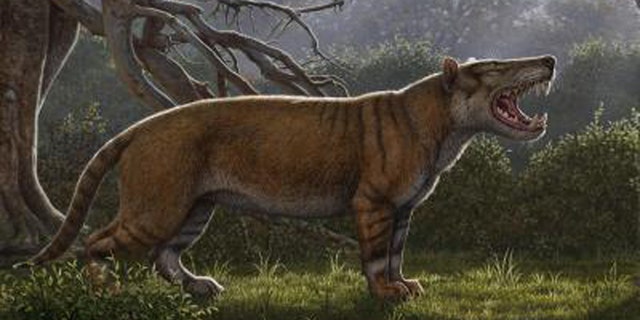Fox News Brief 04-18-2019 07AM
Some people lose their car keys, others lose socks in the dryer. But have you ever lost a 22 million-year-old fossil?
An extinct species of giant mammal has been identified after its bones were discovered in a Kenyan museum drawer decades after being unearthed.
Known as "Simbakubwa kutokaafrika," the "big African lion" was likely at the top of the food chain in Africa, researchers said in a statement. However, it was not "closely related" to any big cats and was a member of an extinct group of mammals called hyaenodonts.
FOSSILIZED REMAINS OF 430 MILLION-YEAR-OLD SEA MONSTER FOUND
"Opening a museum drawer, we saw a row of gigantic meat-eating teeth, clearly belonging to a species new to science," the study's lead author, Dr. Matthew Borths, said in a statement.
The findings have been published in the scientific journal Journal of Vertebrate Paleontology.
It's likely that the fossils found belong to "a relatively young adult" according to the study's abstract, which adds that Simbakubwa differs from "Hyainailouros in exhibiting lingually oriented molar protocones, gracile metastyles, and buccolingually compressed, shearing canines."

Simbakubwa kutokaafrika, a gigantic carnivore known from most of its jaw, portions of its skull, and parts of its skeleton, was a hyaenodont that was larger than a polar bear. (Credit: Mauricio Anton)
The teeth were used to estimate the size of the creature, Borths added, noting the mammal was likely bigger than a polar bear (with a body mass approaching 3,000 pounds) and had a skull larger than a rhinoceros. For comparison purposes, rhinoceros can reach up to 10 feet in length.
It's unclear what caused Simbakubwa to go extinct, as Hyainailourines (part of the hyaenodont group which is unrelated to hyenas) "were some of the largest mammalian carnivores to ever walk the Earth," Borths said in comments obtained by SWNS.
WOOLLY MAMMOTH MYSTERY SOLVED?
Despite it being lost for decades, sitting in a drawer, the fossils are likely to shed new light on an unknown species, as well as what life was like on the African continent before global ecosystems changed significantly between 18 and 15 million years ago.
"This is a pivotal fossil, demonstrating the significance of museum collections for understanding evolutionary history," the study's co-author, Dr. Nancy Stevens, added in the statement.
"Simbakubwa is a window into a bygone era," Stevens continued. "As ecosystems shifted, a key predator disappeared, heralding Cenozoic faunal transitions that eventually led to the evolution of the modern African fauna."
CLICK HERE FOR THE FOX NEWS APP
Source: Read Full Article
